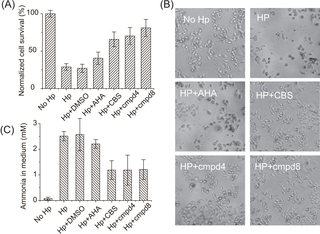PLOS Biology ( IF 9.8 ) Pub Date : 2018-01-10 , DOI: 10.1371/journal.pbio.2003887 Xinming Yang , Mohamad Koohi-Moghadam , Runming Wang , Yuen-Yan Chang , Patrick C. Y. Woo , Junwen Wang , Hongyan Li , Hongzhe Sun

|
Urease as a potential target of antimicrobial drugs has received considerable attention given its versatile roles in microbial infection. Development of effective urease inhibitors, however, is a significant challenge due to the deeply buried active site and highly specific substrate of a bacterial urease. Conventionally, urease inhibitors are designed by either targeting the active site or mimicking substrate of urease, which is not efficient. Up to now, only one effective inhibitor—acetohydroxamic acid (AHA)—is clinically available, but it has adverse side effects. Herein, we demonstrate that a clinically used drug, colloidal bismuth subcitrate, utilizes an unusual way to inhibit urease activity, i.e., disruption of urease maturation process via functional perturbation of a metallochaperone, UreG. Similar phenomena were also observed in various pathogenic bacteria, suggesting that UreG may serve as a general target for design of new types of urease inhibitors. Using Helicobacter pylori UreG as a showcase, by virtual screening combined with experimental validation, we show that two compounds targeting UreG also efficiently inhibited urease activity with inhibitory concentration (IC)50 values of micromolar level, resulting in attenuated virulence of the pathogen. We further demonstrate the efficacy of the compounds in a mammalian cell infection model. This study opens up a new opportunity for the design of more effective urease inhibitors and clearly indicates that metallochaperones involved in the maturation of important microbial metalloenzymes serve as new targets for devising a new type of antimicrobial drugs.
中文翻译:

Metallochaperone UreG作为脲酶抑制剂设计的新目标:开发抗菌药物的新策略
脲酶作为抗微生物药物的潜在靶标,由于其在微生物感染中的多种作用而备受关注。然而,由于细菌尿素酶的深埋的活性位点和高度特异性的底物,有效尿素酶抑制剂的开发是一项重大挑战。常规上,脲酶抑制剂是通过靶向脲酶的活性位点或模仿脲酶的底物来设计的,这是无效的。迄今为止,临床上仅可获得一种有效的抑制剂-乙酰氧肟酸(AHA),但它具有不利的副作用。在本文中,我们证明临床上使用的药物胶体次柠檬酸铋,利用一种不寻常的方式来抑制尿素酶活性,即通过金属伴侣蛋白UreG的功能性扰动破坏尿素酶的成熟过程。在各种致病细菌中也观察到类似现象,这表明UreG可以作为设计新型脲酶抑制剂的一般目标。使用通过虚拟筛选和实验验证相结合,幽门螺杆菌UreG作为展示,我们显示了靶向UreG的两种化合物还可以有效抑制脲酶活性,抑制浓度(IC)为50微摩尔水平,导致病原体的毒力减弱。我们进一步证明了化合物在哺乳动物细胞感染模型中的功效。这项研究为设计更有效的脲酶抑制剂开辟了新的机会,并且清楚地表明,参与重要微生物金属酶成熟的金属伴侣蛋白可作为设计新型抗菌药物的新目标。


























 京公网安备 11010802027423号
京公网安备 11010802027423号